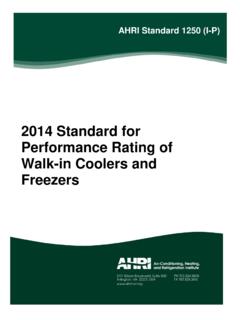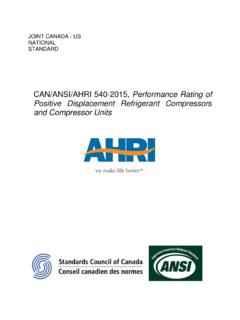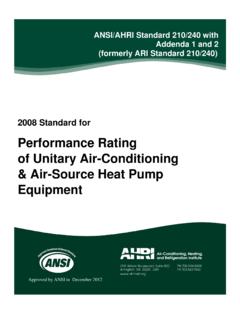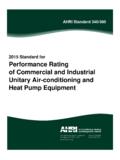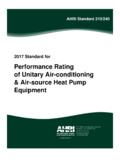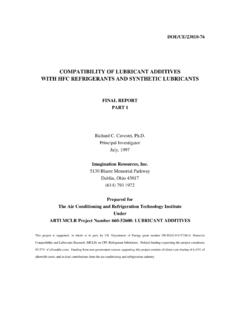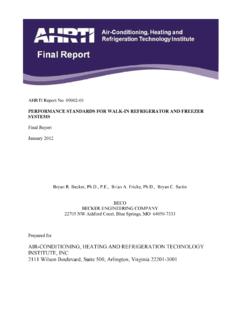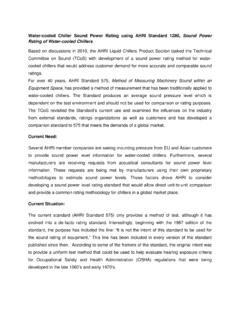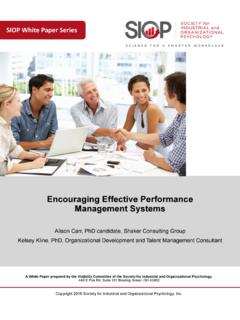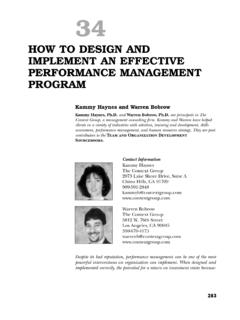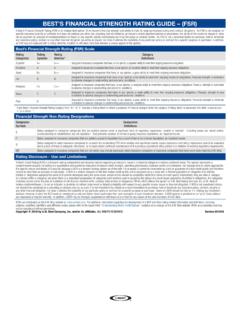Transcription of 2015 Standard for Performance Rating Of Positive ...
1 AHRI Standard 540. 2015 Standard for Performance Rating Of Positive displacement refrigerant Compressors and compressor Units IMPORTANT. SAFETY RECOMMENDATIONS. AHRI does not set safety standards and does not certify or guarantee the safety of any products, components or systems designed, tested, rated, installed or operated in accordance with this Standard /guideline. It is strongly recommended that products be designed, constructed, assembled, installed and operated in accordance with nationally recognized safety standards and code requirements appropriate for products covered by this Standard /guideline. AHRI uses its best efforts to develop standards/guidelines employing state-of-the-art and accepted industry practices. AHRI does not certify or guarantee that any tests conducted under its standards/guidelines will be non-hazardous or free from risk. Notes: This Standard supersedes AHRI Standard 540-2004. It is the responsibility of the user to select its preferred units of measure.
2 Foreword The following are significant changes made in this update: 1) Move away from Standard ratings and work primarily with published ratings a. ratings from coefficients are primary source b. Old tables of Standard Rating conditions would be included in appendix for reference c. Manufacturers can continue to publish information at specific points of interest 2) Different uncertainties for different parts of the Application Envelope a. High Temperature b. Medium Temperature c. Low Temperature 3) More specific information to help with the development of ratings and the verification of the ratings a. Adding statistical aspect to uncertainties b. Incorporation of more specific information on uncertainty 4) Specific guidelines for initial estimates of Performance at different superheat values Price $ (M) $ (NM) Copyright 2015, by Air-Conditioning, Heating, and Refrigeration Institute Printed in Registered United States Patent and Trademark Office TABLE OF CONTENTS.
3 SECTION PAGE. Section 1. Purpose .. 1. Section 2. Scope .. 1. Section 3. Definitions .. 2. Section 4. Test Requirements .. 3. Section 5. Rating Requirements .. 3. Section 6. Minimum Data Requirements for Published ratings .. 6. Section 7. Operating Requirements .. 7. Section 8. Marking and Nameplate Data .. 7. Section 9. Conformance 7. TABLES. Table 1 (I-P). Reference Rating Conditions .. 4. Table 2 (I-P). Application Envelope for the Rating Uncertainties .. 4. Table 1 (SI). Reference Rating Conditions .. 5. Table 2 (SI). Application Envelope for the Rating Uncertainties .. 5. Table 3. Rating Uncertainty Limits for the Verification of Published ratings .. 6. FIGURES. Figure 1 (I-P). Application Envelope for the Rating Uncertainties, with Reference Rating Conditions Shown (Table 1 (I-P)) .. 4. Figure 1 (SI). Application Envelope for the Rating Uncertainties, with Reference Rating Conditions Shown (Table 1 (SI)).. 5. APPENDICES.
4 Appendix A. References - Normative .. 8. Appendix B. References - Informative .. 9. Appendix C. Method to Handle Zeotropic Mixtures - Informative .. 10. Appendix D. Superheat Correction - Informative .. 14. Appendix E. Historical Rating Conditions - Informative .. 15. Appendix F. Verification of Published ratings for Batches of Equipment - Informative .. 17. FIGURES FOR APPENDICES. Figure C1. Cycle Process for Single Component Refrigerants and Azeotropic Mixtures .. 10. Figure C2. Cycle Process for Zeotropic refrigerant Mixtures .. 11. Figure C3. Definitions of Subcooling and Superheating .. 12. TABLES FOR APPENDICES. Table E1. Historical Rating Conditions for Compressors Used in Commercial Refrigeration Applications (Based on 95 F, 35 C Ambient Temperature Surrounding the compressor ) .. 15. Table E2. Historical Rating Conditions for Compressors Used In Air Conditioners and Heat Pumps (Based on 95 F, 35 C Ambient Temperature Surrounding the compressor ).
5 16. Table F1. Rating Uncertainty Limits for the Verification of Published ratings of Batches of Equipment . 17. Table F2. Total Standard Deviations Associated with the Rating Uncertainty Limits for the Verification of Published ratings of Batches of Equipment .. 18. Table F3. Acceptance Criteria for the Verification of Published ratings Using a Sample Size of 1 .. 18. Table F4. Acceptance Criteria for the Verification of Published ratings Using a Sample Size of 3 .. 19. AHRI Standard 540-2015. Performance Rating OF. Positive displacement refrigerant . COMPRESSORS AND compressor UNITS. Section 1. Purpose Purpose. The purpose of this Standard is to establish, for Compressors: definitions, test requirements, Rating requirements, minimum data requirements for Published ratings , operating requirements, marking and nameplate data, and conformance conditions. Intent. This Standard is intended for the guidance of the industry, including manufacturers, engineers, installers, contractors and users.
6 The Standard defines the minimum amount of information, in a Standard form to enable the evaluation and comparison of different Compressors for use in a particular application. Review and Amendment. This Standard is subject to review and amendment as technology advances. Section 2. Scope Scope. This Standard applies to Positive displacement refrigerant Compressors operating in subcritical applications at a fixed displacement . This Standard also applies to the presentation of Performance data for Compressors for air-cooled, evaporative-cooled or water-cooled air-conditioning, heat pump and refrigeration applications. The manufacturer is solely responsible for the determination of values to be used in published product information. This Standard stipulates the minimum amount of information to be provided and suggests a method to be used to verify the accuracy of that information. Exclusions. This Standard does not apply to Compressors employing ammonia, as covered in ANSI/AHRI Standard 510.
7 Or carbon dioxide in subcritical and transcritical applications, as covered in ANSI/AHRI Standard 570 (I-P) and ANSI/AHRI Standard 571 (SI). This Standard does not apply to modulated refrigerant mass flow Compressors or Compressors utilizing vapor injection for the purpose of subcooling to gain capacity. This Standard does not apply to Compressors intended for use in: Household refrigerators and freezers Automotive air-conditioners Dehumidifiers Industrial products other than heating and cooling 1. AHRI Standard 540-2015. Section 3. Definitions All terms in this document will follow the Standard industry definitions in the ASHRAE Terminology website ( ) unless otherwise defined in this section. Batch of Equipment. A number of Compressors intended to perform the same function, produced in quantity, manufactured to the same technical specifications and characterized by the same Published Rating . compressor . A Positive displacement machine in which an increase in refrigerant vapor pressure is attained by changing the internal volume of the compression chamber through work applied to the compressor 's mechanism.
8 This may or may not include other accessories required to sustain operation of the compressor at the Rating conditions. Types of Compressors include Hermetic refrigerant Compressors, Semi-hermetic refrigerant Compressors, and Open Type refrigerant Compressors. Note: Accessories might include fans, liquid receivers, desuperheaters, strainers, service valves, check valves, suction filters, lubricant separators, motor starters, and unloaders, as supplied or specified by the compressor manufacturer. Hermetic refrigerant compressor . A compressor and motor assembly, both of which are contained within a gas tight housing that is permanently sealed by welding, or brazing with no access for servicing internal parts in the field. Open Type refrigerant compressor . A compressor with a shaft or other moving part extending through its casing to be driven by an outside source of power thus requiring a shaft seal or equivalent rubbing contact between fixed and moving parts.
9 Semi-hermetic refrigerant compressor . A compressor and motor assembly contained within a gas-tight housing that is sealed by gasketed joints to provide access for servicing internal parts. Performance Factor. Performance factor shall be computed as a ratio of capacity to power input at specified operating conditions. The potential forms of the Performance factor include, but are not limited to, the energy efficiency ratio (EER) in Btu/h W, coefficient of Performance (COP) in W/W, and ratio of power input to capacity in bhp/ton. Power Input. The time rate of energy usage of the compressor ( compressor power) plus any accessories required to sustain operation of the compressor at the Reference Rating Condition. If accessories are not included it shall be explicitly stated. Published Operating Envelope. The applicable operating envelope for which Equation 1 is valid shall be stated. Equation 1 shall not be used to extrapolate beyond the Published Operating Envelope.
10 Published Rating . A statement of the assigned values of those Performance characteristics, under stated operating conditions, by which a unit may be chosen to fit its application. These values apply to all units of like nominal size and type (identification) produced by the same manufacturer. For a Batch of Equipment, the Published Rating shall represent the expected average value for the batch. The term Published Rating includes the Rating of all Performance characteristics shown on the unit or published in specifications, advertising or other literature controlled by the manufacturer, at Reference Rating Condition. Rating Uncertainty. The limit within which the measured Performance of an individual compressor or a specified large portion of a batch of Compressors can be expected to fall relative to the Published Rating . Reference Rating Conditions. A specific condition selected from Table 1 for quick reference or comparison.

